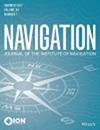Instantaneous Sub-meter Level Precise Point Positioning of Low-Cost Smartphones
IF 2
3区 地球科学
Q1 ENGINEERING, AEROSPACE
引用次数: 0
Abstract
The prevalence of inexpensive g lobal n avigation s atellite s ystem (GNSS) chips that facilitate the performance of carrier phase measurements has provided hardware that can be used as the foundation for implementing precise point positioning (PPP) of low-cost smartphones. However, because of the atmospheric delays and high measurement noise associated with low-quality patch antennae, the convergence time of smartphone PPP can increase from minutes to even hours. By establishing the Satellite-based Ionospheric Model (SIM) and Real-time Tropospheric Grid Point (RTGP) models, we aim to achieve instantaneous sub-meter level positioning for smartphone PPP. In both kinematic and static experiments, Xiaomi Mi8 and Huawei P40 smartphone signals can converge to sub-meter accuracy in the horizontal direction within one to six seconds when adopting multi-constellation and dual-frequency PPP solutions augmented by precise atmospheric corrections. The atmospheric augmentation PPP method effectively improves the convergence speed and positioning accuracy compared to what can be achieved using the conventional PPP algorithm, thereby satisfying smartphone users’ demand for rapid and high-accuracy positioning.低成本智能手机的瞬时亚米级精确点定位
廉价的全球导航卫星系统(GNSS)芯片的普及促进了载波相位测量的性能,为实现低成本智能手机的精确点定位(PPP)提供了硬件基础。然而,由于大气延迟和低质量贴片天线相关的高测量噪声,智能手机PPP的收敛时间可能从几分钟增加到几小时。通过建立基于卫星的电离层模型(SIM)和实时对流层网格点(RTGP)模型,实现智能手机PPP的亚米级瞬时定位。在运动和静态实验中,小米8和华为P40智能手机采用多星座和双频PPP解决方案,加上精确的大气校正,在1 - 6秒内,信号在水平方向收敛到亚米精度。与传统PPP算法相比,大气增强PPP算法有效提高了收敛速度和定位精度,满足了智能手机用户对快速、高精度定位的需求。
本文章由计算机程序翻译,如有差异,请以英文原文为准。
求助全文
约1分钟内获得全文
求助全文
来源期刊

Navigation-Journal of the Institute of Navigation
ENGINEERING, AEROSPACE-REMOTE SENSING
CiteScore
5.60
自引率
13.60%
发文量
31
期刊介绍:
NAVIGATION is a quarterly journal published by The Institute of Navigation. The journal publishes original, peer-reviewed articles on all areas related to the science, engineering and art of Positioning, Navigation and Timing (PNT) covering land (including indoor use), sea, air and space applications. PNT technologies of interest encompass navigation satellite systems (both global and regional), inertial navigation, electro-optical systems including LiDAR and imaging sensors, and radio-frequency ranging and timing systems, including those using signals of opportunity from communication systems and other non-traditional PNT sources. Articles about PNT algorithms and methods, such as for error characterization and mitigation, integrity analysis, PNT signal processing and multi-sensor integration, are welcome. The journal also accepts articles on non-traditional applications of PNT systems, including remote sensing of the Earth’s surface or atmosphere, as well as selected historical and survey articles.
 求助内容:
求助内容: 应助结果提醒方式:
应助结果提醒方式:


